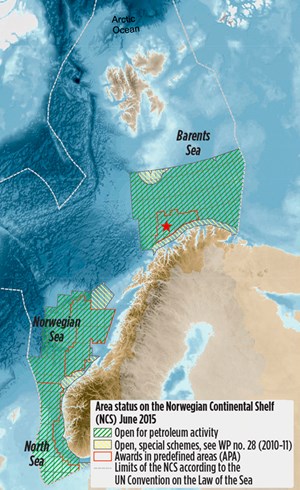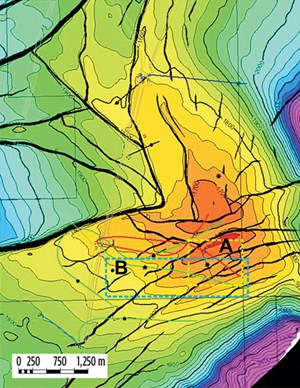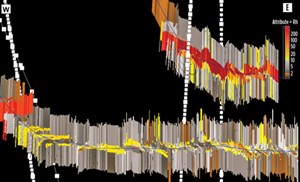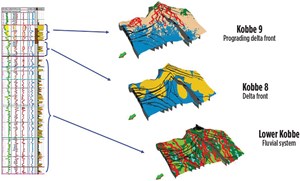Extra-deep azimuthal resistivity improves navigation in a complex Barents Sea reservoir

Goliat is an Eni Norge-operated oil field in the Arctic Barents Sea, 85 km northwest of the city Hammerfest, Fig. 1. The Goliat reservoirs have a complex structure, characterized by a large number of faults and a relatively high structural dip toward the flank of the structure. This challenging combination calls for horizontal production wells for effective drainage.
Goliat field consists of several proven hydrocarbon reservoir units, but only Kobbe producers have been drilled. The Kobbe formation is of Middle Triassic age and is divided into two main subgroups. The Upper Kobbe represents essentially a prograding deltaic system, with mouth bars and tidal-influenced lobes. In the Lower Kobbe, the formation shifts into a more proximal, heterogeneous fluvial setting, where sand bodies have limited lateral continuity.
One particular challenge is that the well design requires the 8½-in. reservoir section to be initiated in the overlaying Snadd shale. To minimize shale exposure in the landing section, aggressive build-up rates are employed, decreasing the length needed in shale. However, a steep approach may lead to deeper penetration in upper Kobbe sandstone, which can result in unwanted intra-shale drilling. Therefore, the key to successful well placement is the early detection of the reservoir top and the accurate mapping of the reservoir sand architecture remote to the wellbore.

One way to successfully navigate a complex reservoir like Goliat is to use the VisiTrak extra-deep azimuthal resistivity (EDAR) tool, which can detect stratigraphic boundaries up to 30 m away from the wellbore in optimal resistivity environments (Hartmann, 2014). The development of advanced, multi-component inversion modeling techniques (Sviridov, 2014) enhances the interpretation of resistivity data, and can accurately provide real-time information regarding reservoir geometry.
At Goliat, the VisiTrak service detected the top of the reservoir at least 20 m TVD and 130 m MD, before entering the reservoir, enhancing accurate wellbore landing. Extra-deep measurements also helped reduce the uncertainty in fault detection, where related throw can be estimated, based on the displacement of boundaries. The use of a measurement with increased depth of detection (DOD), combined with advanced multi-component, inversion-while-drilling techniques, and real-time 3D visualization of data and reservoir modeling, were vital to ensure the well’s successful placement. The VisiTrak provided valuable “Answers While Drilling,” mapping the reservoir geometry in real time, which was key to optimizing reservoir exposure.
BACKGROUND
Optimized wellbore placement within the reservoir has been identified by the oil industry as a key factor in improving oil recovery (Constable et al, 2012). With the limitation regarding seismic resolution, extra-deep azimuthal resistivity provides a unique opportunity for an improved understanding of the reservoir architecture and its near-wellbore sand distribution, that are necessary for optimal placement of the wellbore in the most productive zones of the reservoir.

The Goliat reservoirs have a complex structural setting, characterized by a high number of faults, Fig. 2. The faults are aligned into three main trends, representing the main regional pattern in the Hammerfest basin. Geochemical studies and formation pressure data clearly indicate a lateral separation into several compartments. In addition, stratigraphic barriers reducing or preventing vertical communication have been identified within Kobbe. Results from Wells A and B presented in this article refer to the Upper and Lower Kobbe units, respectively, described in detail below.
The Kobbe formation of Middle Triassic age represents essentially a prograding deltaic system with mouth bars and tidally influenced lobes. In its lower section, the system shifts into a more proximal, heterogeneous fluvial setting. Nine stratigraphic zones have been identified: Kobbe 1 to Kobbe 9 from base to top. The Kobbe reservoir is split into Lower Kobbe (Kobbe 1-7) and Upper Kobbe (Kobbe 8 and 9). The gross vertical thickness of the stratigraphic section is approximately 240 m.
The Upper Kobbe formation represents a prograding delta front environment. Kobbe 9 consists predominantly of fine-grained sandstones, interpreted to be deltaic mouth bar deposits, interbedded with coarse-grained levels interpreted to be fluvial channels, Fig. 3. The deltaic system is prograding toward the west, and an increase in shale content is expected toward the west (prodelta fining deposits) and the east (flood plain shales). From the geological model, Well A is entering the proximal part of the delta, in an area where it is expected to find high amounts of fluvial channel deposits. The main orientation of the fluvial channels in the Upper Kobbe formation is assumed to be from east to west, modeled from 270° to 350°, with a mean of 310°. The width of the channels is modeled in a range between 150 m and 300 m, with a mean of 225 m. The individual channel deposits are a few meters thick, but can be stacked up to 10 m in thickness.
The Lower Kobbe is interpreted to be predominantly composed of fluvial channel deposits separated by flood plain fines. The fluvial channels have generally good porosity and permeability. Some intervals of thin silty sandstones of poorer quality have been identified from the logs. These layers are interpreted to be crevasse splays, and are modeled as thin, fan-shaped layers within the shaly background.
EXTRA-DEEP AZIMUTHAL RESISTIVITY
In the VisiTrak design described in this article, two types of coil arrangements are used, the co-axial differential measurement and a cross-component absolute measurement. For the co-axial measurement, all coils are aligned with the tool axis. The signal attenuation and phase difference between the two receivers are related to the resistivity of the surrounding medium. Attenuation and phase difference also react to remote boundaries, but do not provide azimuthal sensitivity. Spacings and frequencies of this measurement are optimized for the reservoir navigation application (Fang et al., 2005).
For the cross-component measurement, a transmitter orthogonal to the tool axis is used. In a homogeneous medium, symmetry prevents any signal reception by the co-axial receiver. A remote boundary introduces asymmetry in the Eddy current and a measurable signal in the receiver (e.g., Bell et al., 2006). Because of its geometry, this measurement is azimuthally sensitive. One benefit of the cross-component measurement that is particularly useful for this type of tool is the absence of a direct signal as in the coaxial measurement. This achieves large DOD with relatively small transmitter-receiver distances (Zhou, 2009; Hartmann et al., 2014).
The VisiTrak system consists of two sections, Fig. 4. The first section is the shorter transmitter sub that carries the transmitter for the co-axial measurement (Helgesen et al., 2005). The second section is the main sub that contains the receivers for the coaxial and cross-component measurements, as well as a transmitter for the cross-component measurement. The tools are equipped with standard modular connections that allow other components to be placed between the system components.
For the co-axial measurement, the nominal distances are 12 m and 17 m from the transmitter to the first and second receivers, respectively. Actual distances depend on BHA components that are assembled between the two modules. The cross-component measurement uses a distance of 5.75 m from transmitter to receiver. The system is operated at frequencies of 20 kHz and 50 kHz, providing measurements for a wide range of resistivity environments without the need for adjustment. Care was taken in the design to create antenna coil assemblies that are rugged in the field, but provide high sensitivity. This eliminates the need for an additional downhole generator to power the system.
The system performance was qualified by lab and field testing to make sure that accuracy targets were met
(Hartmann et al., 2014). This is particularly important, as the results are used in a quantitative fashion in the real-time inversion application discussed later in this article. To date, the service has been utilized globally on nearly 100 runs.
INVERSION
Combined with a regular deep azimuthal resistivity tool, the VisiTrak system covers a frequency range from 20 KHz to 2 MHz. With the addition of coil orientation (co-axial and cross-component) and signal types (attenuation, phase shift, azimuthal signal strength), the system becomes rather complex. In some very simplistic cases, measured data may still be interpreted visually. For example, bulk-resistivity estimates in thick layers (apparent resistivity) or signal strength increase while approaching an isolated strong contrast. However, in general, to resolve multiple geological features involving larger volumes of rock around the borehole, all measurements have to be analyzed together by means of an advanced inversion technique.
The interpretation approach used for the VisiTrak system is based on an efficient inversion algorithm (Sviridov et al., 2014). For each interval along the well path, a layer-cake earth model is found that predicts the tool responses matching the actual measurements. Combined together along the curtain section, all resulting models present a two-dimensional resistivity map near the wellbore.
There are many possible ways to implement an inversion. However, even for a one-dimensional case, the number of parameters quickly becomes prohibitively large. A relatively simple sand reservoir, with intra-shale, results in a five-layer model that is described by up to 15 parameters. Each layer is described by horizontal resistivity and anisotropy; four-layer boundaries and the formation dip. A complete scan over the whole parameter domain, even on a relatively coarse grid, would yield an enormous number of models that are impossible to check in reasonable time, even using parallel computing on clusters.
We address the challenge by doing the model search much more efficiently. A gradient-based optimization is used to find a local minimum of the data misfit function. Then, an intelligent global scanning is performed in parts of the domain that were not yet tested. In addition, a user-provided expectation helps with convergence, where the model is not strongly defined by the data. Overall, the algorithm’s performance is high enough to run the real-time interpretation on a laptop.

A key consideration for inversion stability is the uncertainty that is always present in any downhole measurements. This is a major reason for non-uniqueness of the inversion results. While main contrasts closer to the borehole can be determined reliably, remote boundaries, potentially screened by other layers, have a larger uncertainty. Thus, a very important step in the interpretation process is the proper incorporation of prior geological knowledge about reservoir structure and properties. The inversion software provides the ability to define plausible parameter ranges, allowing the application of pre-well geological knowledge about the reservoir, as well as new information gained while drilling.
CASE STUDIES
The Goliat drilling campaign utilized the VisiTrak service in oil producer and gas injector wells for optimal wellbore placement. Due to risks associated with drilling and running completion equipment, a maximum dogleg severity of 1.5° per 30 m was identified as the optimum steering capability along the horizontal, 8½-in. reservoir sections. Two wells (Fig. 5) were chosen for the case study, to illustrate the value of the extra-deep azimuthal resistivity measurements in two different geological and resistivity environments.
Well A, a gas injector, highlights the use of the technology, both in a landing scenario and in the continuous mapping of the reservoir top and base in a good, resistivity-contrast environment. Additionally, it illustrates the ability to make strategic decisions, based on all available data when approaching complex areas.
Although it is in the same field, Well B illustrates a different scenario, where the Lower Kobbe reservoir consists of heterogenic channelized sandstones with low lateral continuity. Navigating in such an environment requires constant wellbore trajectory changes to minimize shale exposure. In other words, the scope of steering in the Lower Kobbe was to reduce the length of shale drilled before reaching the next sand.
Part 2. Continuation of this article in the March 2015 issue will include details about reservoir navigation of Wells A and B, and a discussion of the value of the extra-deep azimuthal resistivity measurements. ![]()
ACKNOWLEDGMENTS
The authors thank Eni E&P Norway and the Goliat field partners for supporting the publication of this article. This article is adapted from SPE paper 174929, presented at the SPE ATCE, held in Houston, Texas, Sept. 28–30, 2015.
- Coiled tubing drilling’s role in the energy transition (March 2024)
- Advancing offshore decarbonization through electrification of FPSOs (March 2024)
- Subsea technology- Corrosion monitoring: From failure to success (February 2024)
- Digital tool kit enhances real-time decision-making to improve drilling efficiency and performance (February 2024)
- E&P outside the U.S. maintains a disciplined pace (February 2024)
- U.S. operators reduce activity as crude prices plunge (February 2024)




